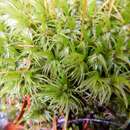en
names in breadcrumbs


This species is sometimes confused with an environmental form of Dicranum undulatum that has nearly percurrent costae and ± acute apices. The aggregate setae of D. ontariense will immediately distinguish it from that form, which has solitary setae. The dull leaves that are contorted when dry, and the leaf apices that are long-acuminate, abundantly spinose on the abaxial surface, are other superficial features to distinguish it from D. undulatum, which has shiny, usually broadly acute, smooth or serrulate leaf apices. Also, on occasion, D. ontariense can be confused with large forms of D. condensatum when sterile. The thin-walled, short-rectangular to quadrate distal-median cells in more or less regular rows of the former will distinguish it from the latter, which has irregularly shaped cells that are thick-walled and usually not in well defined rows. When fruiting, the aggregate setae on some of the plants of D. ontariense will immediately distinguish it from D. condensatum, which has solitary setae.